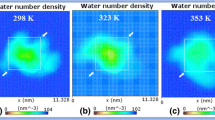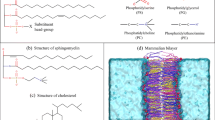Abstract
The density and specific heat of aqueous solutions of Bu4PBr, Ph4PBr, and NaBPh4 have been measured at various temperatures between 10 and 45°C. The derived limiting apparent molal volumes (φ ov ) and heat capacities (φ oc ) have been examined for specific effects in the hydration of alkyl- and aryl-substituted quaternary ions, using also similar results on the tetraalkylammonium series. While φ ov and φ oc of Bu4PBr and Bu4NBr differ only in magnitude by a few percent, the properties of Ph4PBr are sharply distinct, especially φ oc . NaBPh4 also exhibits a distinct behavior in the temperature dependence of its φ oc ; the effect, however, is much less pronounced than that previously reported by other investigators. Within the data presently available, φ oc of hydrophobic ions appears rather invariant with temperature; for the compounds studied here, the relative change in φ oc with temperature is significantly smaller than the relative change in φ ov . These results are correlated with spectroscopic data reported earlier, using a phenomenological description of the two-state behavior of liquid water. The latter is used to calculate the solvent relaxational contribution to the heat capacity of water and to φ oc of the hydrophobic ions.
Similar content being viewed by others
References
C. Jolicoeur, N. D. The, and A. Cabana,Can. J. Chem. 49, 12 (1971).
P. R. Philip and C. Jolicoeur,J. Phys. Chem. 77, 3071 (1973).
C. Jolicoeur and H. L. Freedman,Ber. Bunsenges. Physik. Chem. 75, 248 (1971).
C. Jolicoeur, P. R. Philip, G. Perron, P. A. Leduc, and J. E. Desnoyers,Can. J. Chem. 50, 3167 (1972).
G. Kalfoglou and L. H. Bowen,J. Phys. Chem. 73, 2728 (1969).
J. F. Coetzee and W. R. Sharpe,J. Phys. Chem. 75, 3141 (1971).
C. V. Krishnan and H. L. Friedman,J. Phys. Chem. 75, 3606 (1971).
J. F. Skinner and R. M. Fuoss,J. Phys. Chem. 68, 1882 (1964).
F. J. Millero,J. Chem. Eng. Data 16, 229 (1971); b. F. J. Millero,J. Chem. Eng. Data 15, 562 (1970).
H. S. Frank and W. Y. Wen,Disc. Faraday Soc. 24, 133 (1957).
S. Subramanian and J. C. Ahluwalia,J. Phys. Chem. 72, 2525 (1968).
P. Picker, E. Tremblay, and C. Jolicoeur,J. Solution Chem. 3, 377 (1974).
F. Vaslow,J. Phys. Chem. 70, 2286 (1966).
P. Picker, P. A. Leduc, P. R. Philip, and J. E. Desnoyers,J. Chem. Thermodyn. 3, 631 (1971).
P. Picker, C. Jolicoeur, and J. E. Desnoyers,J. Chem. Ed. 45, 614 (1968).
H. S. Harned and B. B. Owen,The Physical Chemistry of Electrolytic Solutions, 3rd ed. (Reinhold Publishing, New York, 1958).
G. S. Kell,J. Chem. Eng. Data 12, 66 (1967).
H. F. Stimson,Am. J. Phys. 23, 614 (1955).
O. Redlich and D. M. Meyer,Chem. Rev. 64, 221 (1964).
P. R. Philip and J. E. Desnoyers,J. Solution Chem. 1, 353 (1972).
G. Perron and J. E. Desnoyers, to be published.
G. Perron and J. E. Desnoyers,J. Chem. Eng. Data 17, 136 (1972).
M. J. Mastroiani and C. M. Criss,J. Chem. Thermodyn. 4, 321 (1972).
G. Perron and J. E. Desnoyers, private communication.
F. J. Millero,Water and Aqueous Solutions, R. A. Horne, ed. (Wiley-Interscience, New York, 1972), p. 519.
C. Jolicoeur and G. Lacroix,Can. J. Chem. 51, 3051 (1973).
H. Rüterjans, F. Schreiner, U. Sage, and Th. Ackermann,J. Phys. Chem. 73, 986 (1969).
C. M. Davis, Jr., and J. Jarzynski,Advan. Mol. Relax. Processes 1, 155 (1967).
A. Ben Naim,J. Phys. Chem. 69 1922 (1965).
C. M. Davis, Jr., and T. A. Litovitz,J. Chem. Phys. 42, 2563 (1965).
A. Ben Naim,Trans. Faraday Soc,66, 2749 (1970).
A. Eucken,Z. Electrochem. 52, 255 (1948);53, 102 (1949).
C. De Visser and G. Somsen,J. Chem. Thermodyn. 5, 147 (1973).
R. A. Pierrotti,J. Chem. Phys. 69, 281 (1965).
P. R. Philip and C. Jolicoeur,J. Solution Chem., in press.
Author information
Authors and Affiliations
Rights and permissions
About this article
Cite this article
Jolicoeur, C., Philip, P.R. Effect of temperature on the hydration of hydrophobic lons. Apparent molal volumes and heat capacities of Bu4PBr, Ph4PBr, and NaBPh4 in aqueous solutions at various temperatures. J Solution Chem 4, 3–16 (1975). https://doi.org/10.1007/BF00646046
Received:
Revised:
Issue Date:
DOI: https://doi.org/10.1007/BF00646046




